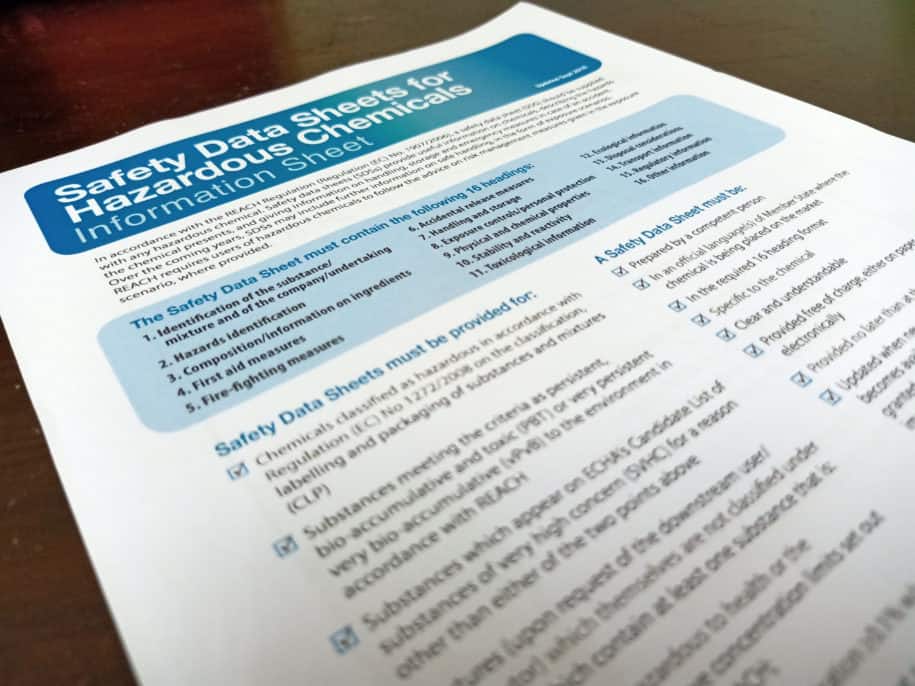A Safety Data Sheet (SDS) is required for any chemical to ensure workplace safety and health. Safety Data Sheets are an essential item in the workplace to learn about the hazards of chemicals and how to handle them safely. Under the revised Hazard Communication Standard (HCS) regulation, a chemical manufacturer, distributor, or importer (i.e., companies who purchase and use the chemicals) must provide the Safety Data Sheets to the downstream users. The Hazard Communication Standard (HCS) is now aligned with the Globally Harmonized System of Classification and Labeling of Chemicals (GHS).
A Safety Data Sheet is a document that consists of comprehensive data of chemical compounds, including its properties, handling, storage, and safety precautions. These documents provide helpful information regarding physical characteristics, the response to exposure, and Personal Protective Equipment (PPE). One Safety Data Sheet should be provided for each chemical.
Based on GHS regulations, every Safety Data Sheet should consist of 16 sections and be presented in a definite order.
- Identification: Must provide the details of the manufacturer, chemical name.
- Hazard Identification: Must include the information regarding the hazard classifications and statements, pictograms for hazard symbols, and precautionary statements.
- Composition/Information on ingredients: Must provide concentration, CAS, and other chemical names. It also includes information on compound or mixture and its trade secret.
- First-aid measures: Must include necessary first-aid steps if there are any symptoms or effects as provided. It is also helpful for knowing immediate medical treatment.
- Fire-fighting measures: Must provide appropriate or inappropriate fire equipment that can be used during hazards and also advises PPE and precautions.
- Accidental release measures: Includes necessary actions during leaks or spillages and methods to clean along with the precautions.
- Handling and storage: Must include the precautions for safe handling and recommends protective storage.
- Exposure controls/Personal protection: Must provide threshold values, exposure limits or any other limits provided by the manufacturer along with the recommended Personal Protective Equipment
- Physical and chemical properties: Lists all the characteristics of the chemical like odor, melting point, solubility, flammability, etc.
- Stability and reactivity: Must include the stability of the chemical at the ambient conditions, possibilities of hazardous reactions, and the conditions that should be avoided.
- Toxicological information: Must provide the information related to the short- or long-term effects of inhalation of toxic chemicals, symptoms, and precautions.
- Ecological information: Includes the harmful effects on the environment.
- Disposal considerations: Advice about suitable methods and containers to dispose of safely.
- Transport information: Includes proper shipping name, transport hazard class, and precautions while transporting a chemical.
- Regulatory information: Safety, health, and environmental regulations specific to the compound.
- Other information: Necessary to include the date of the SDS prepared when the new information is updated, and any other information.
These 16 sections provide all sorts of information for a hazardous chemical should possess. Each section in the SDS has a unique significance. Safety Data Sheets are updated when there is new knowledge on handling, storage, and protective measures, as determined by the manufacturer.
At the workplace, employers should provide SDS to their employees for safety. Every employee should know how to read and understand SDS. Other than manufacturers, EHS software is also providing digital SDS which is readily accessible by the users anytime at the workplace.
For more details: Click here & Contact SafetyStratus Now
AUTHOR BIO

Satya is the resident Chemical Engineer here at SafetyStratus. She is focused on supporting and improving the Chemical Inventory and related products and services for the SafetyStratus platform. She has recently completed her master’s degree in Chemical Engineering. While relatively new to the business world, she has conducted cutting edge research, participated in several notable projects, and worked at a refinery, a steel processing plant, and, most notably, for the Center of Atomic Research. She is eager to use her skills and talents to share knowledge with the broader EHS community.
Follow @Satya: Linkedin
References
- Gilman, L. J. (2016). Safety Data Sheet (SDS) Overview. Retrieved from Ucsd.edu website: https://blink.ucsd.edu/safety/resources/SDS/index.html
- Canadian Centre for Occupational Health and Safety. (2015). Retrieved from Ccohs.ca website: https://www.ccohs.ca/oshanswers/chemicals/whmis_ghs/sds.html
- United States Department of Labor. (2012). Hazard Communication Standard: Safety Data Sheets – OSHA 3514 | Occupational Safety and Health Administration. Retrieved from Osha.gov website: https://www.osha.gov/Publications/OSHA3514.html
- United States Department of Labor. (2015). OSHA QUICK CARD (TM): Hazard Communication Safety Data Sheets | Occupational Safety and Health Administration. Retrieved from Osha.gov website: https://www.osha.gov/Publications/HazComm_QuickCard_SafetyData.html
- United States Department of Labor. (2017). Hazard Communication | Occupational Safety and Health Administration. Retrieved from Osha.gov website: https://www.osha.gov/dsg/hazcom/



